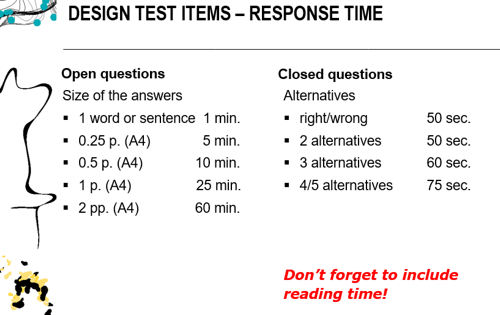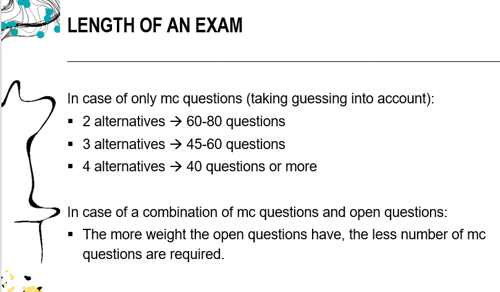toolbox
Considerations when assembling a written test
How do you know how many questions you can use for your test? Of course, this will depend on the time available for the test taking. But it will also depend on the type of questions you'll use, like open or closed questions, or a combination of both. Open questions in general will require more response time than closed ones.
When students are under time pressure, they may make mistakes that have nothing to do with the extent of their learning. Thus, unless your goal is to assess how well students perform under time pressure, it is important to design tests that can be reasonably completed in the time allotted. As a rule of thumb, one way to determine how long a test will take students to complete is to take it yourself and allow students triple the time it took you. But you may also ask a colleague (peer review is always good practice!) or a teaching assistant. Below, you will find an indication of the time questions may take

To make the test reliable, you use a certain number of questions. For open questions, this is a bit more difficult to indicate; it depends most of all on the type of open questions, time available, and making sure the questions cover the learning objectives. For closed questions, there are standard indications, but if you use cases, for instance, of students have to calculate something, this might also ask for more time.

All these guidelines are just a 'rule of thumb'. By conducting a test analysis afterward, you can check whether the length of the test was too long (the last questions are not answered or answered less well, for instance). Also, the student evaluation or complaints during test taking might give an indication.
To read some more about the length of MC tests, see:
- How many questions to include in a multiple-choice test? - Vrije Universiteit Amsterdam
- This is how you combine open and closed questions in a test - Vrije Universiteit Amsterdam
- Combining open and closed questions - how many of each (only in Dutch): Gesloten en Open vragen combineren in een toets – Draaijer
- Some reasons for 40 questions in a MC test Rule of thumb: 40 questions in a 4-choice multiple-choice test. Why? – Draaijer
- Rule of thumb: 40 questions in a 4-choice multiple-choice test – a short follow-up… – Draaijer
